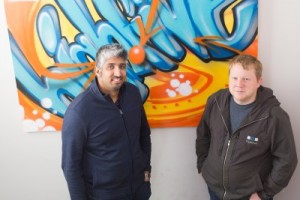Never High-Fived Someone in a Meeting? That May Change.
-
-
slice.mit.edu
Filed Under
Recommended
Along with Jeremy Roy '99, Sinha has cofounded HighFive, a new web-conferencing platform that aims to reinvent how people communicate at work.

Gone are the bulky downloads, elaborate logins, and desktop-centric interfaces that Sinha hates in traditional web-conferencing. There’ll be no need, Sinha vows, to call IT for help with HighFive.
If anyone can outperform WebEx, AnyMeeting, Connect, Jive, Hipchat and the others in the competitive marketplace, it’s Sinha. After leaving Microsoft in 2008, he founded Docverse, document-sharing software that impressed Google enough to buy it and employ him.
At Google, Sinha led the transition of Google Docs into Google Drive, expanding the web-monolith’s ecosystem for large companies that share and edit files in offices and on the fly.
Sinha’s entrepreneurial spirit still sought new opportunities, and, in the past year, he quietly built HighFive. Its full launch is scheduled for early 2014. Investors have flocked early to HighFive, too. Sinha has raised over $13 million, including funds from Dropbox CEO Drew Houston '05 and Google Ventures.
Sinha and Roy became friends at MIT and roommates after college in the early dot-com years.
“Neither of us spent any time in our room together because we caught the entrepreneurial bug and were inspired by everything going on around us in the tech space,” Sinha recalls.
The two spend plenty of time together now, beta-testing HighFive with a cadre of enterprise clients who reportedly love the product.
Though the interface and code for HighFive are still under wraps, industry analysts anticipate success from Sinha’s dream team, whose roster reads like a Silicon Valley yearbook.
Within a decade, Sinha predicts, the nature of work will be radically different.
“The way we communicate at work today is broken,” Sinha says. “We still rely on email, conference calls, and airplanes, and the technologies we use to stay connected end up being the source of the problem. I'm not sure if we'll be the ones to solve the world's biggest problems, but I am sure we'll make communication a whole lot easier for the people who do.”







